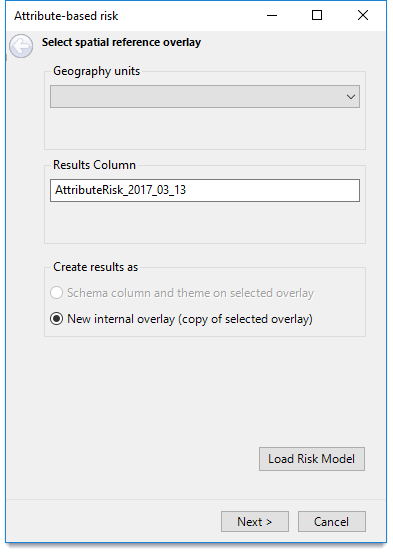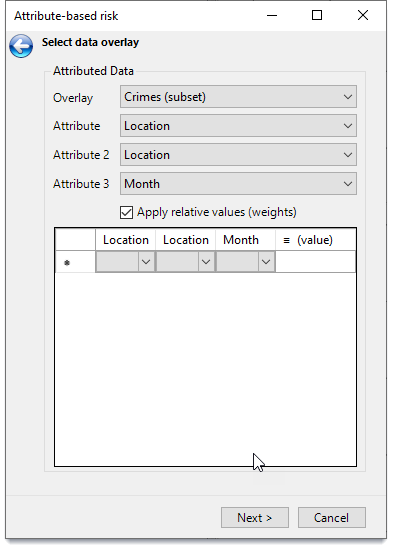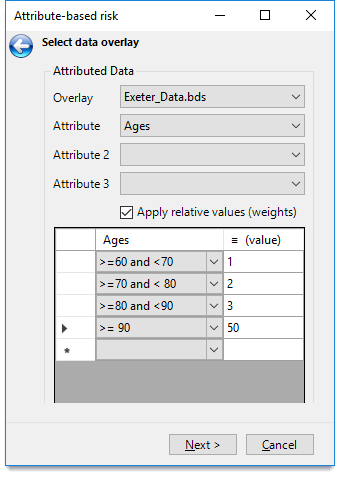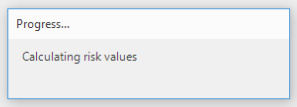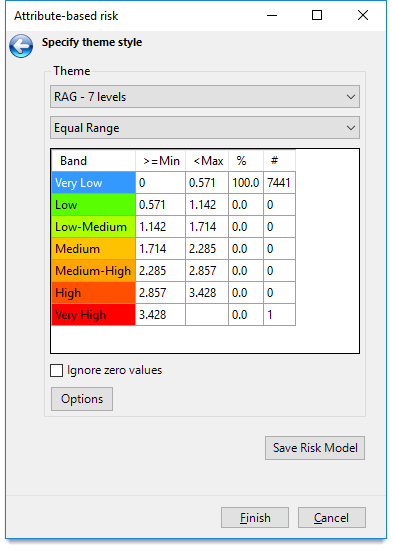Attribute
Creates an attribute-based risk map. This is based on items having specific attributes with specific values within geography units.
Click Applications > Risk and select Attribute. 
This opens the attribute-based risk wizard.
1. Geography units
Select the overlay that will receive the thematic result of the risk calculation. This could be the grid overlay created in the Grid command.
For example:
2. Results Column
This entry specifies the Results Column.
The risk calculation will result in the items in the spatial reference overlay receiving an attribute with their individual risk value.
A default name will be suggested for this attribute – based on the type of risk calculation and the date the command is run.
For example:
You can edit this to any name providing it conforms with the rules of SIS Desktop property names, i.e. alphanumeric and underscore characters only.
The Results Column property is of type double, e.g. AttributeRisk_2017_03_13#.
TIP: The # need not be entered into the Results Column box.
This property is added to the overlay’s schema.
If the schema already includes a property of this name, you will be warned about existing values that may be overwritten:
3. Create results as

Schema column and theme on selected overlay: The Geography units entry at the top of the dialog specifies the overlay on which the resultant risk map is to be based (e.g. super output areas.)
If the selected spatial reference overlay is not editable, only the New internal overlay (copy of selected overlay) option is made available.
4. Load Risk Model
Click Load Risk Model to load a previously saved risk model.
Click Next to select your overlays.
Overlay: All overlays are available from the drop-down, i.e. the analysis can be performed on an invisible overlay.
Attribute/Attribute 2/Attribute 3: Once an overlay has been selected for inspection, you can define up to three attributes/columns for consideration.
Selecting an attribute from a drop-down reserves a column in the grid and populates the column’s drop down with attribute values from the overlay.
Only items meeting the attribute criteria are counted.
Apply relative values (weights)
Relative values (weights) can also be applied so that the criteria the item meets sets a value for that item other than 1 (counted).
Select values from the drop-down for each attribute and enter the (value).
On completion of the Select data overlay dialog click Next.
Wildcards and numeric operators can be used in the attribute values.
The Select data overlay dialog allows multiple values to be entered. For example to include residential detached and semi-detached dwellings the codes to be entered could be:

There are over 20 codes for residential addresses points and it would be tedious to have to specify all residential codes separately.
This is why Risk Modeller allows the use of wildcards (e.g. entering R* will cause the underlying expression to be changed from using = to using like.)
SIS Desktop recognises the wildcard characters * (multiple characters) and ? (single character).
Numeric operators
Let us assume the data contains point items representing persons and includes their age and gender.
To create a risk map based on people over 65 years of age, you may need to find items with age=65, age=66, age=67 etc. This can be a tedious process.
Numeric operators can make this easier. The attribute value column in the grid can accept the following numeric ‘operators’:
>
>=
<
<=
And - (so a range can be specified)
A possible risk map could be based on:
Here is an example of how you can create a risk map based on all derelict commercial and residential properties.
In addition, you may want to weight commercial properties as having twice the risk.
If using AddressBase Plus, you can look for all properties with a classification starting with ‘C’ or ‘R’ and a state of 3:
Attribute types
Use of this command requires an understanding/appreciation of the underlying property types.
The command evaluates the expression behind the chosen attribute and the user input text; the comparison result will depend on if the expression yields a number or text.
For example, in a text comparison the risk ‘calculation’ will strip leading and trailing whitespace from values in the data.
In the case of the Exeter data example above, the command performs a numeric comparison even though the selected attribute was a string – Ages$.
The risk values will be calculated. This process may take some time; check the progress bar periodically.
Once the values have been calculated, you can set theme styles.
Use the drop-down menu to set the theme style.
There are two sets of Themes:
- RAG: Red Amber Green risk colours
- Heat – based on green to red hotspot colours.
TIP: Themes are defined in the Risk Modeller's configuration file: riskModellerConfig.xml.
Use the second drop-down to define how the bands are calculated for the current set of results (i.e. by Equal Range, Percentiles or Equal Count.)
A note on Percentiles:
Percentile band values can be changed by editing the values in the >=
The theme Band ranges can be manually adjusted by entering new values in the >=Min column. These are then used as the defaults for future uses of the theme.
The decision to use any of these options depends on the actual values.
Next check the Ignore zero values tickbox if required.
Click Options to display the Theme Settings dialog:.png)
| Option | Description | |
|
Theme pen for geography units |
If required change the pen style by selecting a style from the Style drop-down box. |
|
|
When ignoring zero values |
Check the Set zero values blank in theme tickbox to prevent all zero values which could result in large areas of colour being shown in the output grid. |
|
|
Theme Labels |
Check the Label ranges with numeric limits tickbox to label the ranges with numeric values. |
|
Click OK to save the Risk Model.
Click the Save Risk Model button if you want to save the risk model settings.
The model settings will be saved as a .JSON file.
Click Finish on the Specify theme style dialog.
